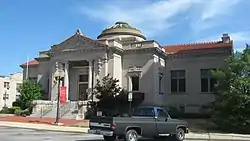Anderson, Indiana
Anderson is a city in Madison County, Indiana, United States.[5] Named after Chief William Anderson, it is the county seat of Madison County. The city is the headquarters of the Church of God (Anderson) and home of Anderson University, which is affiliated with the Church of God. Highlights of the city include the historic Paramount Theatre and the Gruenewald House.
Anderson, Indiana | |
|---|---|
| City of Anderson | |
Downtown Anderson | |
 Seal | |
| Nickname: “Queen City of the Gas Belt” | |
| Motto: Performance. Talent. Inspiration. | |
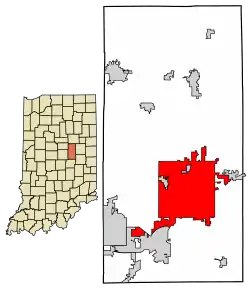 Location in Madison County, Indiana. | |
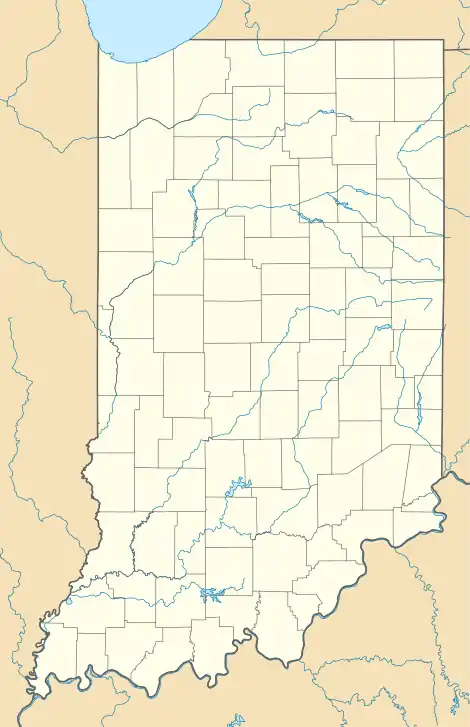 Anderson  Anderson  Anderson | |
| Coordinates: 40°6′0″N 85°40′53″W | |
| Country | United States |
| State | Indiana |
| County | Madison |
| Townships | Anderson (primarily) Adams, Fall Creek, Lafayette, Richland, Union (small sections) |
| Government | |
| • Mayor | Thomas Broderick Jr. (D) |
| Area | |
| • Total | 41.71 sq mi (108.04 km2) |
| • Land | 41.60 sq mi (107.74 km2) |
| • Water | 0.11 sq mi (0.29 km2) |
| Elevation | 879 ft (268 m) |
| Population | |
| • Total | 54,788 |
| • Density | 1,317.08/sq mi (508.52/km2) |
| Time zone | UTC−5 (EST) |
| • Summer (DST) | UTC−4 (EDT) |
| ZIP codes | 46011, 46012, 46013, 46016, 46017 |
| Area code | 765 |
| FIPS code[2][4] | 18-01468 |
| GNIS ID[2][4] | 430152 |
| Website | www |
The population was 54,788 at the 2020 census.[3]
History
Prior to the organization of Madison County, William Conner entered the land upon which Anderson is located. Conner later sold the ground to John and Sarah Berry, who donated 32 acres (13 ha) of their land to Madison County on the condition that the county seat be moved from Pendleton to Anderson. John Berry laid out the first plat of Anderson on November 7, 1827. In 1828 the seat of justice was moved from Pendleton to Anderson.
The city is named for Chief William "Adam" Anderson, whose mother was Lenape and whose father was of Swedish descent. Chief Anderson's name in Lenape was Kikthawenund, meaning "creaking boughs".[6] The Lenape village was known as "Anderson's Town", though the Moravian missionaries called it "The Heathen Town Four Miles Away". Anderson was also known as "Andersonton" before being formally organized as Anderson.
Introduction of internal improvements by the Mammoth Internal Improvement Act caused a growth in the population in 1837. In December 1838, Anderson was incorporated as a town with 350 inhabitants. The Central Canal, a branch of the Wabash and Erie Canal, was planned to come through Anderson. Work continued on the canal during 1838 and the beginning of 1839, but the work was soon suspended by the state following effects of the Panic of 1837. The town again became a sleepy village until 1849, when it was incorporated a second time as a town. Many new commercial ventures located around the courthouse square.
This incorporation was short-lived, and Anderson once again went back to village status in 1852. However, with the completion of the Indianapolis Bellefontaine Railroad, as well as their station in 1852, Anderson burst to life. The third incorporation of Anderson as a town occurred on June 9, 1853. The population continued to increase. On August 28, 1865, with a population of nearly 1,300 people, Anderson was incorporated as a city.
Between 1853 and the late 19th century, twenty industries of various sizes located there. On March 31, 1887, natural gas was discovered in Anderson. As the Indiana gas boom began, this discovery led new businesses that could use natural gas, such as glass-making, to move to the city. Anderson grew to such proportions that a Cincinnati newspaper editor labeled the city "The Pittsburgh on White River". Other appellations were "Queen City of the Gas Belt" and (because of the vulcanizing and rubber tire manufacturing business) "Puncture Proof City".
In 1897 the Interurban Railroad was born in Anderson. Charles Henry, a large stock holder, coined the term "Interurban" in 1893. It continued to operate until 1941.
The year 1912 spelled disaster for Anderson: the natural gas ran out. The city had left its gas-powered lights on day and night, and there are stories of a pocket of natural gas being lit in the river and burning for a prolonged period for the spectacle of it. The result of the loss of natural gas was that several factories moved out. The whole city slowed down. The Commercial Club (formed on November 18, 1905) was the forerunner of the present chamber of commerce.
This club persuaded the Remy brothers to stay in Anderson and others to locate there. For decades, Delco Remy and Guide Lamp (later Fisher Guide), which during World War II built the M3 submachine gun and the FP-45 Liberator pistol for the Allies, were the top two employers in the city. From 1913 through the 1950s, the Ward-Stilson Company was one of the country's largest producers of uniforms, regalia, furniture and props for the Freemasons, the Odd Fellows, and dozens of other U.S. fraternal organizations.
The Church of God of Anderson located its world headquarters in Anderson in 1905. Anderson Bible School was opened in 1917, and this was separated from Gospel Trumpet (now known as Warner Press) in 1925. At the same time, it became known as Anderson Bible School and Seminary. In 1925, the name was changed to Anderson College and eventually to Anderson University in 1988.
Over the years, 17 different types of automobiles were manufactured in Anderson, with the Lambert family among the city's leaders in its development and the Buckeye Gasoline Buggy the Lambert product. Many other inventions were perfected in Anderson, including the gas regulator (Miron G. Reynolds), the stamp vending machine (Frank P. Dunn), clothes presser (H. Donald Forse), "Irish Mail" handcars (Hugh Hill), flower car for funeral homes (Francis M. McClain, automatic gearshift (Von D. Polhemus)), Sisson choke (Glenn Sisson), and the vulcanizing process to retread tires (Charles E. Miller).
Anderson hosted a National Basketball Association (NBA) franchise for the 1949–50 season, being one of the smaller cities to have had a major league franchise in a Big Four American sport. The Anderson Packers were a founding member of the NBA (under that name), but folded after one season.[7][8]
Like most other industrial cities in Indiana and the Rust Belt as a whole, Anderson suffered tremendously from deindustrialization in the 1970s and 1980s. For example, nearly 22,000 people were employed by General Motors in the 1970s in Anderson; by 2006 this number had declined to fewer than 2,600. Anderson has since struggled with higher rates of poverty and unemployment.
Geography
Anderson is located in south-central Madison County at 40°06′00″N 85°40′53″W.[9] The city of Anderson occupies all of Anderson Township except for the much smaller communities of Country Club Heights, Edgewood, River Forest, and Woodlawn Heights, as well as small parts of five other townships: Lafayette, Richland, Union, Adams, and Fall Creek.
Indiana State Road 32 (14th Street) crosses the city center, leading east-northeast 19 miles (31 km) to Muncie and west-southwest the same distance to Noblesville. State Road 9 (Scatterfield Road) crosses the east side of the city, leading north 11 miles (18 km) to Alexandria and southwest 10 miles (16 km) to Pendleton. Interstate 69 crosses the southeast corner of the city, with access from Exit 226 (SR 9/SR 109). I-69 leads southwest 40 miles (64 km) to Indianapolis and northeast 83 miles (134 km) to Fort Wayne.
According to the U.S. Census Bureau, Anderson has a total area of 41.7 square miles (108.00 km2), of which 41.6 square miles (108 km2) are land and 0.1 square miles (0.3 km2), or 0.27%, are water.[1] The White River flows east to west through the northern part of the city.
Climate
| Climate data for Anderson(Sewage PLT)-2006-2020 normals | |||||||||||||
|---|---|---|---|---|---|---|---|---|---|---|---|---|---|
| Month | Jan | Feb | Mar | Apr | May | Jun | Jul | Aug | Sep | Oct | Nov | Dec | Year |
| Average high °F (°C) | 35.4 (1.9) |
38.2 (3.4) |
50.8 (10.4) |
62.8 (17.1) |
73.3 (22.9) |
81.5 (27.5) |
83.9 (28.8) |
82.4 (28.0) |
76.9 (24.9) |
64.9 (18.3) |
50.9 (10.5) |
40.2 (4.6) |
61.8 (16.5) |
| Daily mean °F (°C) | 28.1 (−2.2) |
30.3 (−0.9) |
41.9 (5.5) |
52.4 (11.3) |
63.4 (17.4) |
71.9 (22.2) |
74.3 (23.5) |
72.8 (22.7) |
66.9 (19.4) |
55.2 (12.9) |
42.6 (5.9) |
33.3 (0.7) |
52.8 (11.5) |
| Average low °F (°C) | 20.8 (−6.2) |
22.3 (−5.4) |
33.1 (0.6) |
42.1 (5.6) |
53.4 (11.9) |
62.2 (16.8) |
64.8 (18.2) |
63.3 (17.4) |
56.9 (13.8) |
45.4 (7.4) |
34.3 (1.3) |
26.4 (−3.1) |
43.8 (6.5) |
| Average precipitation inches (mm) | 2.79 (71) |
3.03 (77) |
4.15 (105) |
4.73 (120) |
4.38 (111) |
5.89 (150) |
3.94 (100) |
3.64 (92) |
2.92 (74) |
3.70 (94) |
3.57 (91) |
3.54 (90) |
46.28 (1,175) |
| Average snowfall inches (cm) | 7.0 (18) |
6.6 (17) |
1.6 (4.1) |
0.2 (0.51) |
trace | 0.0 (0.0) |
0.0 (0.0) |
0.0 (0.0) |
0.0 (0.0) |
trace | 0.4 (1.0) |
5.1 (13) |
20.9 (53.61) |
| Average extreme snow depth inches (cm) | 5 (13) |
4 (10) |
2 (5.1) |
0 (0) |
0 (0) |
0 (0) |
0 (0) |
0 (0) |
0 (0) |
0 (0) |
0 (0) |
4 (10) |
5 (13) |
| Average precipitation days (≥ 0.01 Inches) | 10 | 8 | 11 | 12 | 13 | 12 | 9 | 8 | 8 | 11 | 9 | 10 | 121 |
| Average snowy days (≥ 0.1 Inches) | 4 | 4 | 1 | 0 | 0 | 0 | 0 | 0 | 0 | 0 | 0 | 3 | 12 |
| Average relative humidity (%) | 71 | 68 | 67 | 65 | 67 | 68 | 69 | 68 | 64 | 65 | 70 | 73 | 68 |
| Mean monthly sunshine hours | 114.7 | 138.4 | 186 | 210 | 266.6 | 306 | 313.1 | 294.5 | 246 | 204.6 | 156 | 127.1 | 2,563 |
| Mean daily sunshine hours | 3.7 | 4.9 | 6 | 7 | 8.6 | 10.2 | 10.1 | 9.5 | 8.2 | 6.6 | 5.2 | 4.1 | 7.0 |
| Mean daily daylight hours | 9.7 | 10.7 | 12 | 13.3 | 14.4 | 15 | 14.7 | 13.7 | 12.4 | 11.1 | 10 | 9.4 | 12.2 |
| Average ultraviolet index | 2 | 2 | 3 | 4 | 5 | 6 | 6 | 6 | 4 | 2 | 2 | 2 | 4 |
| Source 1: NOAA NCEI[10]National Weather Service(Snow-Precipitation days)[11] | |||||||||||||
| Source 2: Weather Atlas(Sun-daylight-UV)[12]climate data(Humidity)[13] | |||||||||||||
| Climate data for Anderson, Indiana | |||||||||||||
|---|---|---|---|---|---|---|---|---|---|---|---|---|---|
| Month | Jan | Feb | Mar | Apr | May | Jun | Jul | Aug | Sep | Oct | Nov | Dec | Year |
| Record high °F (°C) | 69 (21) |
72 (22) |
85 (29) |
90 (32) |
96 (36) |
104 (40) |
105 (41) |
102 (39) |
103 (39) |
92 (33) |
81 (27) |
75 (24) |
105 (41) |
| Average high °F (°C) | 32.3 (0.2) |
36.5 (2.5) |
48.1 (8.9) |
60.7 (15.9) |
71.6 (22.0) |
80.6 (27.0) |
83.7 (28.7) |
81.6 (27.6) |
75.7 (24.3) |
63.9 (17.7) |
50.4 (10.2) |
37.1 (2.8) |
60.2 (15.7) |
| Average low °F (°C) | 17.4 (−8.1) |
20.9 (−6.2) |
31.5 (−0.3) |
40.3 (4.6) |
50 (10) |
59.3 (15.2) |
63.2 (17.3) |
61.1 (16.2) |
54.3 (12.4) |
43.1 (6.2) |
34.4 (1.3) |
23.5 (−4.7) |
41.6 (5.3) |
| Record low °F (°C) | −24 (−31) |
−19 (−28) |
−7 (−22) |
16 (−9) |
23 (−5) |
36 (2) |
42 (6) |
39 (4) |
26 (−3) |
15 (−9) |
−4 (−20) |
−22 (−30) |
−24 (−31) |
| Average rainfall inches (cm) | 2 (5.1) |
2.2 (5.6) |
3.5 (8.9) |
4 (10) |
3.8 (9.7) |
3.5 (8.9) |
4.1 (10) |
3.4 (8.6) |
3.1 (7.9) |
2.6 (6.6) |
3.3 (8.4) |
3.1 (7.9) |
38.6 (97.6) |
| Average snowfall inches (cm) | 6 (15) |
5.7 (14) |
2.3 (5.8) |
0.3 (0.76) |
0 (0) |
0 (0) |
0 (0) |
0 (0) |
0 (0) |
0 (0) |
0.8 (2.0) |
4.8 (12) |
19.2 (49) |
| Source 1: [14] | |||||||||||||
| Source 2: [15] | |||||||||||||
Demographics
| Census | Pop. | Note | %± |
|---|---|---|---|
| 1850 | 383 | — | |
| 1860 | 1,196 | 212.3% | |
| 1870 | 3,126 | 161.4% | |
| 1880 | 4,126 | 32.0% | |
| 1890 | 10,741 | 160.3% | |
| 1900 | 20,178 | 87.9% | |
| 1910 | 22,476 | 11.4% | |
| 1920 | 29,767 | 32.4% | |
| 1930 | 39,804 | 33.7% | |
| 1940 | 41,572 | 4.4% | |
| 1950 | 46,820 | 12.6% | |
| 1960 | 49,061 | 4.8% | |
| 1970 | 70,787 | 44.3% | |
| 1980 | 64,695 | −8.6% | |
| 1990 | 59,459 | −8.1% | |
| 2000 | 59,734 | 0.5% | |
| 2010 | 56,129 | −6.0% | |
| 2020 | 54,788 | −2.4% | |
| Source: US Census Bureau | |||
2010 census
As of the 2010 census,[16] there were people, households, and families living in the city. The population density was 1,356.8 inhabitants per square mile (523.9/km2). There were housing units at an average density of 675.7 per square mile (260.9/km2). The racial makeup of the city was 78.8% White, 15.2% African American, 0.3% Native American, 0.5% Asian, 2.6% from other races, and 2.6% from two or more races. Hispanic or Latino of any race were 4.8% of the population.
Of the extant households 28.8% had children under the age of 18 living with them, 35.8% were married couples living together, 17.1% had a female householder with no husband present, 5.5% had a male householder with no wife present, and 41.6% were non-families. 34.5% of all households were made up of individuals, and 13.8% had someone living alone who was 65 years of age or older. The average household size was 2.28 and the average family size was 2.91.
The median age in the city was 37.8 years. 22.4% of residents were under the age of 18; 11.5% were between the ages of 18 and 24; 24.8% were from 25 to 44; 24.9% were from 45 to 64; and 16.3% were 65 years of age or older. The gender makeup of the city was 47.9% male and 52.1% female.
2000 census
As of the 2000 census,[17] there were people, households, and families living in the city. The population density was 1,491.6 inhabitants per square mile (575.9/km2). There were housing units at an average density of 690.3 per square mile (266.5/km2). The racial makeup of the city was 81.99% White, 14.88% African American, 0.31% Native American, 0.49% Asian, 0.02% Pacific Islander, 0.86% from other races, and 1.45% from two or more races. Hispanic or Latino of any race were 2.07% of the population.
There were 25,274 households, out of which 27.0% had children under the age of 18 living with them, 41.4% were married couples living together, 15.1% had a female householder with no husband present, and 39.0% were non-families. 33.1% of all households were made up of individuals, and 14.0% had someone living alone who was 65 years of age or older. The average household size was 2.28 and the average family size was 2.87.
In the city, the age distribution of the population shows 23.2% under the age of 18, 11.2% from 18 to 24, 27.6% from 25 to 44, 21.3% from 45 to 64, and 16.6% who were 65 years of age or older. The median age was 36 years. For every 100 females, there
Government
The city government consists of a mayor and a city council. The mayor is elected in citywide vote. The city council consists of nine members. Six are elected from individual districts. Three members are elected at large.
Economy
When General Motors closed its operations in Anderson, the city was dealt a major economic blow, as GM was the biggest employer in Anderson.[18] Nevertheless, in 2007, Anderson was ranked 98th in the Forbes List for 100 Best Places for Businesses among Smaller U.S. Metro areas.[19] However, a more recent (2014) appraisal of Anderson from the Indiana Business Review was mixed, noting that "long-term trends are negative", citing "a long-term downward trend in area employment" and "acceleration in the number of food stamp recipients". More recent unemployment has been reduced, but improvements still lag behind the rest of the state.[20]
For 2013, estimated household median income was $33,574 (vs. Indiana state median of $48,248). Per capita money income was $18,216 (Indiana per capita of $24,635). 25.8% of the city's population was estimated at living below poverty level, vs. a statewide estimation of 15.4%.[21] Madison County, of which Anderson is the seat, has nearly three times as many food stamps recipients per capita as does Indiana as a whole.[22][23]
As of February 2019, the ten largest employers in Madison County were:[24]
| Rank | Employer | # of employees |
|---|---|---|
| 1 | Community Hospital Anderson | 1,980 |
| 2 | St. Vincent Health | 1,410 |
| 3 | Nestlé | 790 |
| 4 | Hoosier Park | 785 |
| 5 | Carter Express | 680 |
| 6 | Anderson University | 530 |
| 7 | Continuum | 500 |
| 8 | Kroger/Pay Less Super Markets | 440 |
| 9 | Greenville Technology Inc. | 395 |
| 10 | Walmart | 365 |
Points of interest
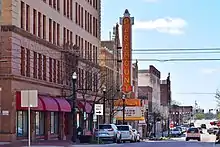
- Anderson Center for the Arts (listed on the National Register of Historic Places)
- Anderson Speedway, home of the Pay Less Little 500 and Redbud 400
- Downtown Historic District (NRHP-listed)
- Hoosier Park Racing and Casino
- Madison County Historical Center
- Mounds State Park (NRHP-listed), adjacent to the eastern border of the city
- Paramount Theatre (NRHP-listed)
- Shadyside Memorial Park and Lake
- Additional locations on the National Register of Historic Places:[25]
Education
Anderson's public school district is the Anderson Community School Corporation, which includes one high school, Anderson High School which serves grades 9 – 12; one junior high school, Highland Middle School (formerly Highland High School) which serves grades 6 – 8, six elementary schools (Eastside, Edgewood, Valley Grove, 10th Street, Erskine, Anderson Elementary) which serve k -5, a kindergarten center (Killbuck), and a preschool (Southview). Until 1997, Anderson had three high schools: Highland, Madison Heights and Anderson. In 1997 Madison Heights was closed and Anderson High School moved into that facility. Beginning in the fall of 2010, Highland High School closed and was converted into a junior high school, consolidating all students in grades 9-12 into Anderson High School.
Anderson also has a charter school (non-traditional, tuition-free public school) called Anderson Preparatory Academy. Currently, Anderson Preparatory Academy features grades K-12. Anderson Preparatory Academy is a college preparatory, military-based academy. All cadets in grades 6-8 are members of the Civil Air Patrol. High school cadets are all members of the Air Force JROTC program. Original plans called to only offer grades 6–9, then add on another upper grade each year before extending the lower years.
Anderson University is within the city, as are a campus of the Ivy Tech Community College of Indiana and a campus of the Purdue Polytechnic Institute.
The city has a lending library, the Anderson Public Library.[26]
In fiction
In the comic strip Peanuts, a book in the fictional series beloved by Snoopy, "The Six Bunny Wunnies", is called The Six Bunnie-Wunnies and Their Layover in Anderson, Indiana. (Charles Schulz had been recently awarded an honorary degree by Anderson College.)
Anderson is the home of several characters in the alternate history novel The Man with the Iron Heart by Harry Turtledove.
Anderson is mentioned as a character's hometown in the Stephen King novel, The Talisman.
Notable people
- Carl Erskine, Professional baseball player, BKN/LA Dodgers Pitcher from 1948-1959. (1955 World Series Champion) Still resides in the area (96), opened a very nice elementary school on the south side of town. Also has a baseball complex dedicated to him on Columbus Ave.
- Jalen Haralson, La Luminare Basketball, Top 5 Basketball Recruit Class Of ‘25.
- Harold Achor, justice of the Indiana Supreme Court
- Jermaine Allensworth, professional baseball outfielder
- Lowell Amos, convicted "Black Widower" murderer
- Melvin E. Biddle, World War II Medal of Honor recipient
- Don Brandon, Hall of Fame baseball coach from Anderson University
- Jann Browne, country music singer
- Gary Burton, jazz vibraphonist
- Bob Carey, Indy car driver
- Everett Case, nicknamed "Gray Fox", basketball coach notable for tenure at North Carolina State University, 1946–1964
- Buck Crouse, MLB catcher
- James Davis, politician, U.S. Secretary of Labor
- Winfield T. Durbin, politician, former governor of Indiana
- Cory Edwards, producer of Hoodwinked!; created internet series Krogzilla on Smosh's Shut Up Cartoons channel
- Gordon Gordon, crime novelist
- Krystal Harris, singer
- Charles L. Henry, politician, congressman, coiner of term "interurban"
- Orville Hodge, embezzler
- Gary Hoover, businessman, author, entrepreneur
- Robert Kessler, 1st Team All-American and 2x First-team Big Ten basketball player for Purdue University from 1933 to 1936
- James Kilgore, Symbionese Liberation Army member
- John William Lambert, inventor of first successful U.S. gasoline automobile
- Adam Lind, MLB player for Washington Nationals, Seattle Mariners
- Matt Lutz, actor
- Von Mansfield, NFL defensive back
- Brittany Mason, model
- Mack Mattingly, politician, Georgia senator
- Gary McGhee, professional basketball player
- Jon McLaughlin, singer
- Phyllis Reynolds Naylor, author
- Phill Niblock, composer and filmmaker
- Bruce Nickells, harness racing driver and trainer[27]
- Sandi Patty, singer
- Amber Portwood, TV personality
- James Rebhorn, actor
- Kris Roe (The Ataris), singer
- Fred Mustard Stewart, author
- Kevin Stein, poet laureate of Illinois
- Max Terhune, actor
- Ray Tolbert, basketball player for Indiana's 1981 NCAA championship team
- Albert Henry Vestal, majority whip of House of Representatives, 1923–1931
- Len Walston, singer-songwriter and music producer
- Louis J. Weichmann, witness for the prosecution in the trial of the alleged conspirators involved in the assassination of Abraham Lincoln
- Bob Wilkerson, basketball player for Indiana's undefeated 1976 NCAA championship team
- Jumping Johnny Wilson, basketball and baseball player
References
- "2022 U.S. Gazetteer Files: Indiana". United States Census Bureau. Retrieved April 10, 2023.
- "Feature ID 430152". Geographic Names Information System. United States Geological Survey. Retrieved June 30, 2014.
- "P1. Race – Anderson city, Indiana: 2020 DEC Redistricting Data (PL 94-171)". U.S. Census Bureau. Retrieved April 10, 2023.
- "FIPS55 Data: Indiana". FIPS55 Data. United States Geological Survey. February 23, 2006. Archived from the original on June 18, 2006. Retrieved June 30, 2014.
- "Find a County". National Association of Counties. Archived from the original on May 31, 2011. Retrieved 2011-06-07.
- "Madison County Historical Society". andersonmchs.com. Archived from the original on January 30, 2018. Retrieved April 24, 2018.
- "Anderson Packers". basketball-reference.com. Sports Reference LLC. Archived from the original on May 11, 2010. Retrieved July 4, 2009.
- "Anderson Leaves Pro Hoop Ranks". Spokane Daily Chronicle. April 11, 1950. Retrieved September 4, 2009.
- "US Gazetteer files: 2010, 2000, and 1990". United States Census Bureau. February 12, 2011. Retrieved April 23, 2011.
- "NOAA NCEI U.S. Climate Normals Quick Access". National Oceanic and Atmosoheric Administration. Retrieved September 19, 2023.
- "Climate". NOAA. Retrieved September 19, 2023.
- "Yearly & Monthly Weather - Anderson, IN". weather atlas. Retrieved September 19, 2023.
- "Anderson Climate:Temperature & Weather by Month". Climate data. Retrieved September 19, 2023.
- "Weatherbase". Weatherbase. Archived from the original on September 16, 2012. Retrieved January 3, 2011.
- "The Weather Channel". Archived from the original on October 23, 2012. Retrieved January 3, 2011.
- "U.S. Census website". United States Census Bureau. Retrieved December 11, 2012.
- "U.S. Census website". United States Census Bureau. Retrieved 2008-01-31.
- Peters, Jeremy W.; Maynard, Micheline (February 20, 2006). "Company Town Relies on G.M. Long After Plants Have Closed". The New York Times. Archived from the original on March 12, 2016.
- "100 best Places for Businesses among Smaller U.S. Metro areas". Forbes. May 2007. Archived from the original on February 26, 2009. Retrieved March 20, 2009.
- "Anderson Forecast 2015". 2014. Archived from the original on December 31, 2014. Retrieved December 31, 2014.
- "State & County Quick Facts, Anderson (city), Indiana". 2014. Archived from the original on September 19, 2012. Retrieved December 31, 2014.
- "Madison County, Indiana". 2014. Archived from the original on December 31, 2014. Retrieved December 31, 2014.
- "Indiana". 2014. Archived from the original on April 8, 2018. Retrieved December 31, 2014.
- "Leading Employers". Madison County Corporation for Economic Development. 2014. Archived from the original on June 30, 2014. Retrieved August 7, 2019.
- "National Register Information System". National Register of Historic Places. National Park Service. July 9, 2010.
- "Indiana public library directory" (PDF). Indiana State Library. Archived (PDF) from the original on February 18, 2017. Retrieved March 10, 2018.
- "BRUCE NICKELLS - Harness Museum". harnessmuseum.com. Archived from the original on March 16, 2018. Retrieved April 24, 2018.
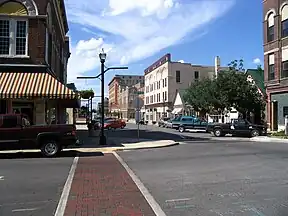
.jpg.webp)
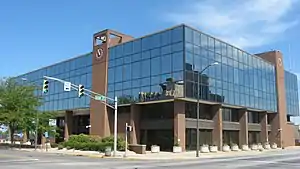
%252C_Anderson%252C_Indiana%252C_Nov_4th%252C_2011.jpg.webp)

